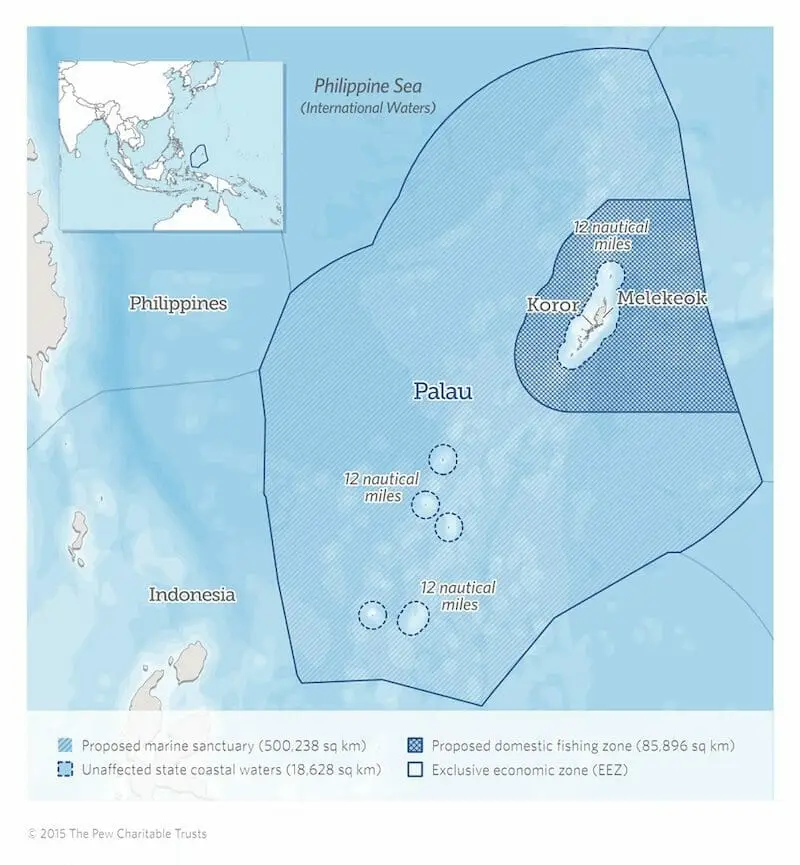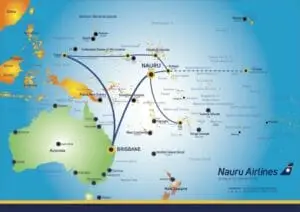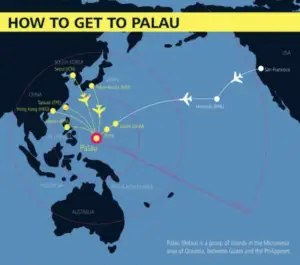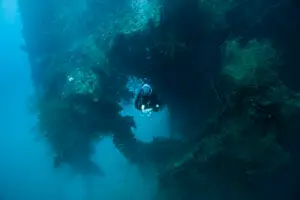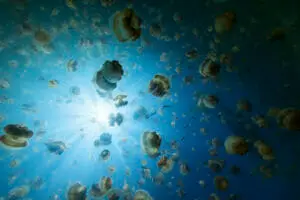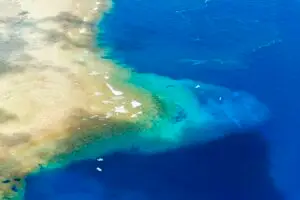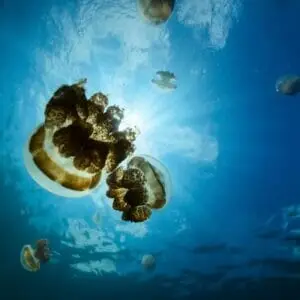🐠 Palau’s Ocean Legacy — Where Conservation Meets Adventure
In the heart of the Pacific, there’s a place where the ocean isn’t just scenery, it’s sacred. Where reef sharks glide like sentinels through crystal-clear currents, and where every diver who enters the water becomes part of a larger story, one of protection, respect, and purpose.
That place is Palau.
Long celebrated for its breathtaking dive sites, Palau is more than just a world-class diving destination. It’s a global blueprint for marine conservation, a nation that has repeatedly chosen preservation over exploitation, and backed it up with bold, groundbreaking action.
From declaring the world’s first shark sanctuary in 2009 to protecting 80% of its waters through the Palau National Marine Sanctuary Act, this island nation has transformed itself into one of the most forward-thinking ocean protectors on Earth.
And it’s not just about policy — it’s about people. In Palau, conservation is cultural. The reef isn’t something separate from daily life; it’s part of identity, heritage, and survival.
Concepts like the bul (a traditional fishing ban) and the Palau Pledge (a promise every visitor must sign) show that protecting the ocean is as much about values as it is about science.
As a guest from Palau Dive Adventures, you don’t just see this legacy — you’ll experience it.
You’ll drop into shark-rich walls like Blue Corner, explore well-preserved WWII wrecks, and you will hover in manta-filled channels, and surface with a deeper understanding of what marine conservation can look like when an entire nation gets behind it.
This post is your guide to that story.
You’ll learn how Palau is leading the way in global ocean protection — and how every dive you take here plays a role in preserving one of the most vibrant marine ecosystems left on the planet.
Table of Contents
🌍 A Small Island with a Giant Vision
Palau may be small — a chain of over 300 islands in the western Pacific — but when it comes to ocean conservation, its impact is anything but.
With a population under 20,000, Palau has emerged as one of the world’s most daring defenders of marine biodiversity, often making decisions that larger nations only talk about.
Why? For Palau, the ocean isn’t optional; it’s everything.
The sea provides food, culture, income, and identity. It’s a living resource that sustains both the present and the future.
That understanding runs deep in Palauan society, rooted in centuries-old customs like the bul — a traditional moratorium used by chiefs to protect reef areas until fish stocks recover.
Long before there were marine biologists, there were village elders watching the tides and managing the reef with intuitive, generational wisdom.
This intimate connection to the ocean has helped shape some of the most ambitious conservation policies on the planet. Palau’s leaders haven’t just followed the global sustainability movement — they’ve helped define it.
From hosting high-level climate summits to advocating for “marine spatial planning,” Palau has positioned itself as a pioneer of ocean governance.
Former President Tommy Remengesau Jr. famously declared, “The ocean is our livelihood — and we must be its guardian.”
This vision came to life with bold policies like the Palau Shark Sanctuary and the Palau National Marine Sanctuary, which you’ll explore in the next sections.
Together, these decisions form what many now call the Palauan Model — a powerful blend of cultural respect, scientific guidance, and political will.
It’s an approach that proves a small island nation can lead a global movement — and divers from around the world are invited to be part of it.
🦈 The Palau Shark Sanctuary: A First-of-Its-Kind Global Commitment
In 2009, Palau stunned the world by announcing something no country had ever done before: it declared its entire exclusive economic zone a shark sanctuary — the first national-level shark haven in the world.
This bold move instantly protected over 600,000 square kilometers of ocean from commercial shark fishing, finning, and trade.
At the time, shark populations were plummeting globally due to overfishing, and most nations remained hesitant to act. Palau, with fewer than 20,000 citizens, didn’t hesitate.
It drew a line in the water, and the world took notice.
The Palau Shark Sanctuary quickly became a model for other nations. Its message was simple but radical: sharks are worth more alive than dead.
As apex predators, sharks are critical to healthy reef ecosystems, and as tourism icons, they bring lasting economic value.
For divers, the sanctuary changed everything.
Sites like Blue Corner, Ulong Channel, and New Drop Off became synonymous with guaranteed shark encounters. Schools of grey reef sharks, patrolling white-tips, and the occasional hammerhead turned dive trips into cinematic wildlife encounters — no cages, no bait, just wild sharks behaving naturally in protected waters.
Palau’s sanctuary has since inspired similar designations in the Maldives, Honduras, and the Bahamas. But it was Palau that went first — and it did so proudly.
Today, when you dive any of the famous dive sites here, you’re not just chasing underwater thrills. You’re witnessing a conservation legacy in motion. Every shark you see is a reminder that protection works — and that small nations can make a massive difference when they lead with courage.
🏛️ The Palau National Marine Sanctuary: A Bold Ocean Commitment
In a world grappling with climate change and overfishing, Palau chose to lead, not follow.
In 2014, President Remengesau declared his vision to transform Palau’s national waters into a fully protected sanctuary:
“We want to close our waters to commercial fishing and become the world’s largest marine sanctuary.”
A year later, that vision became law.
In 2015, the Palau National Marine Sanctuary Act passed, establishing one of the most ambitious ocean conservation efforts on Earth. The legislation designated 80% of Palau’s exclusive economic zone (EEZ) — an area roughly the size of France — as a no-take zone, closed to all commercial fishing, mining, and extractive activity.
The remaining 20% was carved out as a Domestic Fishing Zone, carefully managed to support local food security. This shift redirected the nation’s policy from commercial export (98% of its tuna was once sold abroad) toward domestic resilience.
Implementation officially began in January 2020, and early results are promising:
Increased tuna biomass in adjacent waters
Greater regional enforcement collaboration
Rising global recognition of Palau’s leadership in ocean governance
But the sanctuary wasn’t just about reefs and tuna — it was about people.
With over 50% of the national GDP tied to tourism, Palau’s leaders understood that preserving their marine environment was economic common sense. As Remengesau stated:
“We want to be known for our pristine marine sanctuary — not for industrial fishing.”
For divers, this commitment isn’t theoretical. It’s something you see and feel underwater:
🦈 shark-rich walls,
🌊 undisturbed coral slopes
🐟 pelagic schools gliding through untroubled currents.
This act transformed Palau into a living model of marine protection, where conservation is not just written into law, but brought to life on every dive.
🛰️ Enforcement & Technology: “Eyes in the Sky” for a Vast Blue Nation
When Palau declared its Exclusive Economic Zone (EEZ) a marine sanctuary the size of France, the challenge wasn’t just political — it was logistical.
How do you monitor and protect 500,000 square kilometers of ocean with just 20,000 people and a modest budget?
Palau’s answer: strategic partnerships, cutting-edge surveillance, and global collaboration.
🌐 Satellites & Smart Surveillance
Palau works closely with organizations like the Pew Charitable Trusts and OceanMind, which provide satellite vessel monitoring systems (VMS) capable of tracking ship movements in real-time.
These systems use automatic identification signals (AIS) and radar overlays to detect unusual patterns, like fishing vessels lingering in no-take zones or “going dark” by disabling their transponders. When a red flag is raised, enforcement teams are notified immediately.
This allows Palau to focus patrol efforts efficiently, even without a massive navy.
🚤 Patrol Vessels & Regional Partnerships
On-the-water enforcement is bolstered by Australian-donated Pacific-class patrol boats, part of a regional effort to strengthen marine security across Micronesia.
These vessels are staffed by local marine law enforcement and can respond quickly to suspicious activity within Palauan waters. Patrols are coordinated with satellite data and are sometimes joined by NGO observers and regional task forces.
The presence of visible enforcement — even symbolic — acts as a powerful deterrent.
✈️ Aerial & Radar Coverage
Palau has also experimented with aerial surveillance, using small aircraft, drones, and radar arrays to monitor activity in areas that patrol boats can’t easily reach.
Radar installations are particularly useful for spotting unregistered or non-compliant vessels operating at night or far offshore.
Combined with satellite tracking, these tools give Palau what officials call “eyes in the sky” — a way to watch over their waters 24/7.

🔥 What Happens to Poachers? Palau Sends a Clear Message
Palau doesn’t just rely on satellite alerts or radar pings to defend its sanctuary; it also relies on visible deterrence and cultural resolve.
When illegal fishers are caught inside the protected zone, their boats are seized and publicly burned on the shoreline. These burnings aren’t just about punishment — they’re about sending a message:
“If you come here and fish illegally, we will take your boat and burn it.”
This uncompromising stance has drawn headlines across Asia and Oceania, with Palau positioning itself as a nation not just declaring conservation, but defending it with action.
For locals, it’s a source of pride. For potential poachers, it’s a blazing red line. For the ocean, it’s working.
🤝 The Power of Partnerships
What makes Palau’s enforcement system so effective isn’t just the technology — it’s the collaborative model. NGOs, governments, scientists, and local leaders work together to:
Share real-time data
Conduct joint training
Coordinate regional enforcement
Advocate for stronger global regulations
This multi-layered approach has made Palau a leader not just in declaring protections, but in defending them.
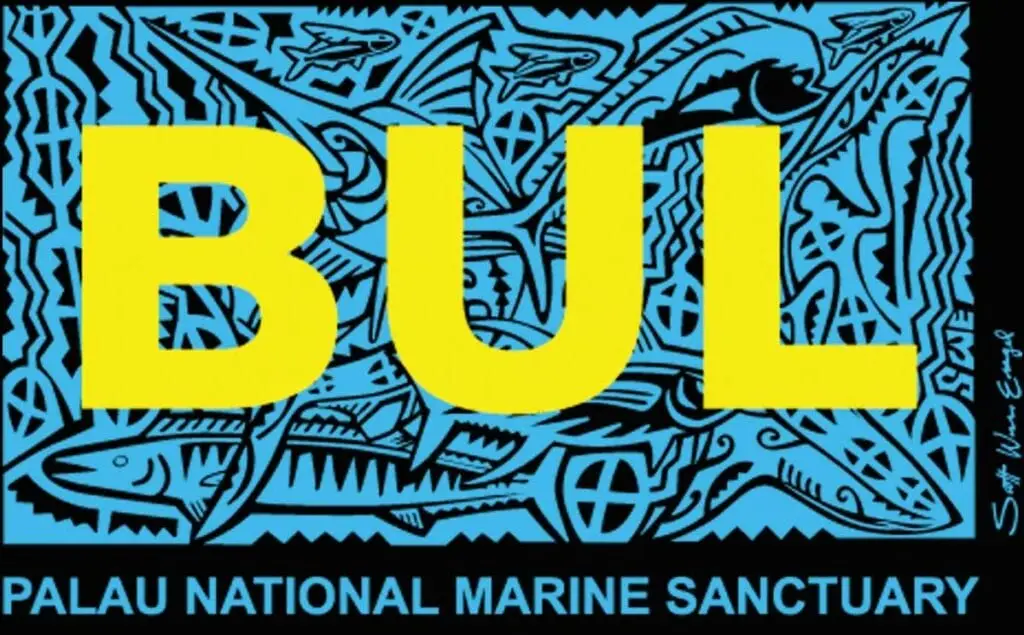
🧭 The “Bul” — Palau’s Traditional Reef Protection System
Long before satellite surveillance or national legislation, Palauans had already mastered the art of marine conservation through a cultural practice known as the bul.
A bul is a traditional moratorium declared by village chiefs (rubak), often with community consensus, to temporarily ban fishing or harvesting in specific reef areas.
These closures allow fish stocks to recover, spawning grounds to remain undisturbed, and natural cycles to reestablish balance, all based on generations of ecological knowledge.
What makes the bul so powerful isn’t just the science behind it — it’s the social contract.
When a bul is in effect, it’s respected. Not because of fines or formal enforcement, but because of deeply held cultural values rooted in chelid, or respect for the ocean, for elders, for future generations.
In many communities, breaking a bul is considered a moral failure as much as a legal one.
Even today, bul practices are active across Palau. In some villages, elders and community leaders still collaborate to place reefs under bul protection during critical seasons, like grouper spawning or coral bleaching recovery.
These locally led efforts often work in tandem with national marine policy, influencing the design of protected areas and reinforcing the message that conservation isn’t just modern science, it’s ancestral wisdom.
For visiting divers, learning about the bul adds depth to every dive. You’re not just swimming through a protected site; you’re moving through a reef system that’s been cared for by its people for hundreds of years.
Palau’s marine protection doesn’t begin with paperwork. It begins with the people.
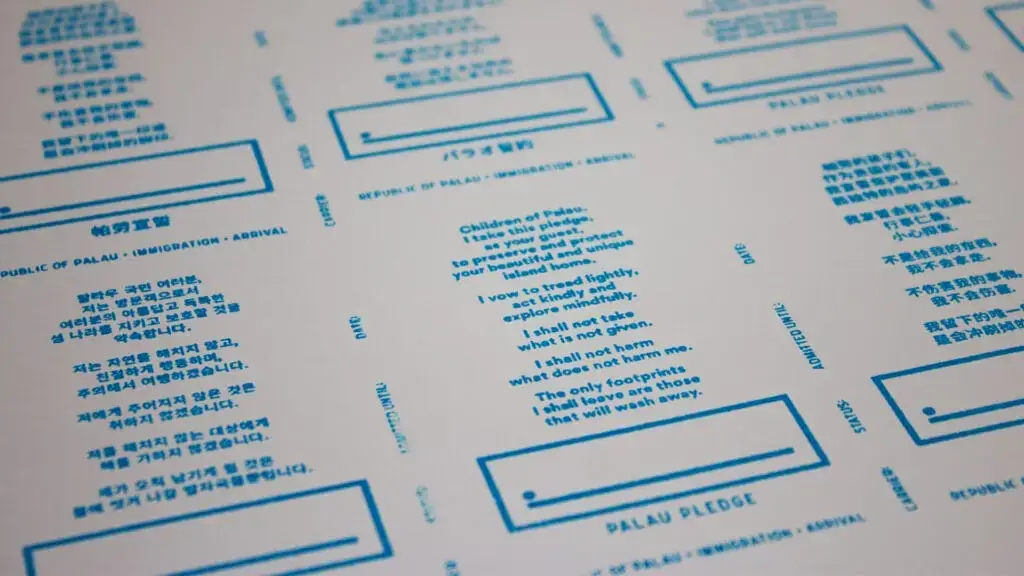
🪸 The Palau Pledge — Conservation Begins at Customs
It’s not every day that a country asks you to sign a promise when you land. But in Palau, that’s exactly what happens — and it’s beautiful.
The Palau Pledge is a mandatory commitment every visitor signs upon arrival. It’s stamped into your passport and written as a promise to Palau’s children — a vow to protect the islands and their ocean home for future generations.
“Children of Palau, I take this pledge, as your guest, to preserve and protect your beautiful and unique island home. I vow to tread lightly, act kindly and explore mindfully.”
This isn’t just symbolic. It’s actionable.
Since its launch in 2017, the pledge has reshaped tourism in Palau, setting the tone from the moment you arrive. It reminds travelers to tread lightly, respect wildlife, avoid single-use plastics, and never touch or take anything from the reef.
It’s also legally backed:
Reef-toxic sunscreens are banned
Feeding or disturbing marine life is prohibited
Fines are issued for destructive behaviors like anchoring on coral
The pledge has won sustainability awards and inspired similar models around the world — from Galápagos to Bhutan. But in Palau, it’s more than policy. It’s personal.
At Palau Dive Adventures, we don’t just support the pledge — we live it. It’s woven into our briefings, our dive protocols, and our daily habits. Because when you dive with intention, you don’t just see the reef — you help protect it.
🌿 Diving with Purpose — How Visitors Can Help Protect Palau’s Reefs
Every diver who enters Palau’s waters has a choice — to simply observe or to become part of the protection effort.
Palau’s marine environment is one of the most vibrant and biologically rich in the world. But it’s also fragile. The very currents that bring nutrient-rich water to the reefs can also carry sunscreen chemicals and microplastics if we’re not careful. That’s why responsible diving isn’t optional here; it’s essential.
Here’s how you can dive with purpose in Palau:
Use reef-safe sunscreen, or better yet, skip it
Palau became the first country in the world to ban reef-toxic sunscreens, citing their direct link to coral bleaching and developmental harm in fish.
Use mineral-based options free of oxybenzone, octinoxate, and parabens — or wear a rash guard and skip sunscreen altogether.
Practice perfect buoyancy and avoid reef contact
Even a gentle brush from a fin or camera arm can damage fragile coral structures. Stay neutrally buoyant, maintain awareness of your surroundings, and never touch, chase, or stand on the reef. PDA guides will help you fine-tune your trim.
Use reef hooks correctly
In strong currents, reef hooks help you stay in place without touching the reef, but only when used properly. We’ll show you how to hook in sandy or rubble areas, never on live coral.
Follow local briefings and dive group size limits
Palau Dive Adventures caps dive group sizes and avoids crowded sites when possible. Our dive briefings include conservation reminders — not because we don’t trust you, but because we care about giving you a better dive and a healthier ocean.
Be an ambassador above the surface, too
Respect local customs, reduce single-use plastics, and share your experience with others. Conservation in Palau isn’t just underwater, it’s a way of thinking, traveling, and living with care.
🤝 Book a Dive Trip That Supports Palau’s Ocean Protection
Every time you dive in Palau, you’re part of something bigger than just a vacation.
When you choose a dive operator that’s committed to conservation, your trip actively supports local efforts to protect marine life, strengthen sustainable tourism, and educate fellow divers.
At Palau Dive Adventures, this isn’t just a philosophy; it’s how we operate, every single day.
Why It Matters
Small groups mean less reef impact and more personal attention.
Local guides who understand the ecosystem and share its stories.
Daily briefings that emphasize safety, respect, and reef preservation.
Eco-conscious practices — from reef-safe sunscreen reminders to responsible boat anchoring.
We don’t run dive cattle boats. We don’t rush you through the sites.
We take our time, dive with care, and make every encounter count.
🤿 Ready to Dive With Purpose?
Whether you’re passionate about sharks, drawn to pristine coral, or simply want your dive dollars to make a difference, you’ve found the right place.
Frequently Asked Questions About Marine Conservation in Palau
The Palau Pledge is a groundbreaking conservation initiative that every visitor must sign upon entry. Stamped into your passport, the pledge is a promise — directed to the children of Palau — to act responsibly and minimize environmental impact during your stay.
Created in 2017 with input from local youth, it symbolizes the nation’s belief that true conservation includes personal accountability. The pledge is backed by legal frameworks that ban reef-toxic sunscreens, prohibit wildlife disturbance, and enforce sustainable tourism practices.
It has won global awards for its innovation and has been recognized as a new model for ecotourism ethics.
In 2009, Palau became the first nation in the world to declare its entire EEZ a shark sanctuary, protecting over 600,000 square kilometers of ocean. This historic move banned all commercial shark fishing and finning within Palauan waters.
At the time, global shark populations were collapsing, and Palau’s bold stance demonstrated that small island nations could lead on big environmental issues.
Today, the sanctuary has become a blueprint for similar conservation efforts in other regions and has helped revitalize Palau’s dive tourism by ensuring healthy shark populations in key dive sites like Blue Corner.
Yes. In 2018, Palau became the first country to ban reef-toxic sunscreens. The law prohibits the sale and use of products containing ingredients like oxybenzone and octinoxate, which have been proven to harm coral DNA, inhibit coral growth, and increase bleaching.
The ban supports Palau’s broader reef protection goals and is enforced at entry points, dive shops, and resorts. Visitors are encouraged to use reef-safe, mineral-based sunscreens or wear protective clothing like rash guards instead.
Yes — diving is allowed in many protected areas as long as no extractive activities occur.
Sites within the Rock Islands Southern Lagoon UNESCO World Heritage Site and around Koror State are accessible to divers, and much of Palau’s marine tourism takes place in areas where sharks and reefs are protected, but visitation is permitted.
However, there are no-take zones within the National Marine Sanctuary where commercial fishing is prohibited, and visitors must always follow dive briefings and local guidance to ensure compliance and minimal impact.
Palau is a global leader in ocean protection. From banning destructive sunscreen to protecting 80% of its waters, Palau’s marine policies are considered some of the most progressive and impactful in the world.
Passed in 2015 and enacted in 2020, the Palau National Marine Sanctuary Act established one of the largest fully protected marine reserves in the world. It closed off 80% of Palau’s Exclusive Economic Zone (EEZ) — an area the size of France — to all commercial fishing, seabed mining, and extractive activity. The remaining 20% is managed as a domestic fishing zone to support local food security. The sanctuary not only protects critical habitats and migratory routes but also reinforces Palau’s role as a global leader in ocean conservation.
A bul is a traditional Palauan practice where village chiefs (known as rubak) temporarily prohibit fishing or resource extraction from specific areas. Rooted in ancestral ecological knowledge, a bul allows ecosystems to recover during spawning seasons or after signs of stress.
These community-enforced closures are respected not because of legal penalties, but because of deeply embedded cultural values tied to respect for the environment (chelid). Today, bul declarations often complement modern marine management, reinforcing that in Palau, conservation is both ancient and ongoing.

